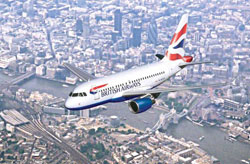Airbus is considering moving its high-performance computing centre to a colder climate to combat rising power and cooling costs in France and Germany.
Airbus CIO Guus Dekkers said the company needs to take action to offset rising energy costs in its supercomputer facilities.

The aircraft maker pioneered the idea of a "supercomputer in box", when it installed two ready built supercomputers at its sites in Toulouse, France, and Hamburg, Germany, over four years ago.
But rising energy costs will mean that if computer power continues to accelerate at its present rate, annual energy costs could run into millions of euros within a few years.
Dekkers, speaking at the International Supercomputer conference in Hamburg, said that moving the datacentres in Northern Europe could reduce energy costs by at least 20%.
Cooling costs would be lower, and Airbus count benefit from lower cost hydroelectric power, he told Computer Weekly.
"You build your datacentre ideally next to a hydroelectric power plant, so you get your energy, not for free, but at a much lower costs," he said.
Airbus plans to issue a tender to upgrade its existing supercomputer service next year, and Dekkers said it makes sense to relocate the service at the same time.
"Whether they are based in Hamburg or Toulouse or Sweden or Finland, I don't care, as long as the service level agreement is guaranteed for connectivity," he said.
"My ballpark would be 20% saving compared to what you would run today."
Airbus buys in its super computing power on a pay-per-teraflop contract. This gives the ability to replace its supercomputer containers with faster, more energy efficient models every few years.
"The savings in energy are so substantial that you really have a business case for replacing something after two or three years," said Dekkers.
The datacentres are returned to the manufacturer, and either scrapped, or sold to another customer.
"The last switchover took less than four weeks to get the whole datacentre replaced," he said.
The main challenge in moving the datacentres to Northern Europe would be finding a way to give Airbus engineers remote access to the huge quantities of information generated by the system.
But Dekkers said the technology already exists to process the data into a usable form, before sending summary results back to Airbus over dedicated lines.
"Basically it means allowing people to access through remote graphics, so you are not transferring the data itself which can be terabytes, but [instead transferring] graphical images which represent the data," he said.
Dekkers introduced the datacentres to Airbus some four years ago, following a programme to centralise the manufacturer's supercomputer operations.
"We had teraflops left and right in the company. I wanted to consolidate that," he said.
The 40-foot long Performance Optimised Datacentres (PODs), supplied by HP, contain servers, storage, networking, software , and integrated power and cooling.
The French installation was ranked 29th in the top 500 list of the world's most powerful computers last year and is one of the largest commercial supercomputers. Today the combined datacentres operate at a speed of 376 teraflops, and is ranked among the 50 largest supercomputing environments worldwide."
The systems have helped Airbus to make significant breakthroughs in aircraft design and aerodynamic simulations, and allowed the company to reduce the time and money spent on wind tunnel testing.
Airbus' high-performance computing (HPC) resources helped to drive market share to 65% last year, putting it ahead of US rival Boeing.
"Put it this way - I believe it would be impossible to design an A380 or an A350, the way they are today without using HPC," said Dekkers.
HPC modelling has also made a significant contribution to reducing the noise levels of the latest generation of aircraft.
The A380 was the first aircraft to be designed using HPC for aerodynamic modelling. Although it is twice the size of the earlier A330, its noise levels are no greater.
"You can't say that is due to HPC alone, but it provides a major working tool for the engineering community to take the right decisions and to reflect what design decisions are doing to the overall performance of the aircraft," he said.
Dekkers predicted that supercomputers would open up new areas of development, such as modelling the climate for passengers inside an aircraft, and the impact of a lightning strike.
However, rising energy costs mean that Airbus and other companies that make use of HPC will need to take steps to minimise power consumption.
"Look what Germany is doing. Germany is debating building for a lot of money, electricity lines up to Sweden and Norway in order to make use of electrical power," said Dekkers.
"It would make more sense to move those high energy consuming elements up north, and then invest once into a much cheaper connection, than bring that same energy from up north to western Europe, that is crazy."





